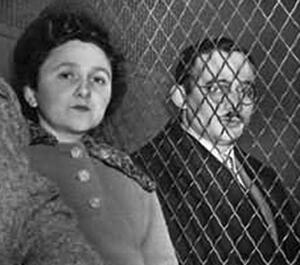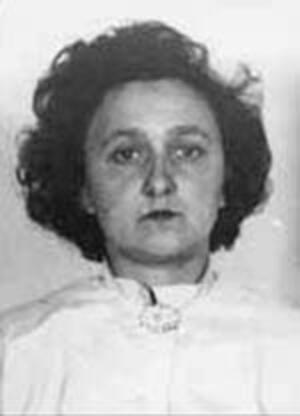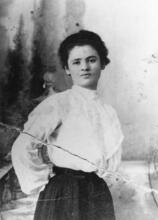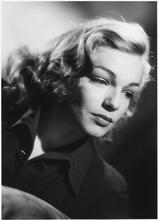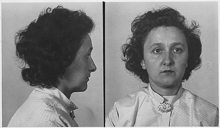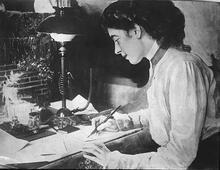Ethel Rosenberg
Ethel Rosenberg’s Jewish identity was forged not by any ties to traditional Judaism but by her political radicalism. Indeed, when she and her husband, Julius, were charged with espionage, attempts were made by their fellow "leftists" to link their prosecution with antisemitism. But the established Jewish community, fearing any association with Jewish radicalism, rejected this charge. The couple was convicted on March 29, 1951, and sentenced to death, the only two American civilians to be executed for espionage-related activity during the Cold War.
Born into poverty on New York's Lower East Side, Ethel Rosenberg initially wanted to pursue a career in theater. While working at a packing and shipping company, she became introduced to leftist radicalism and unionist activities. After her marriage to Julius Rosenberg, a committed Communist, Ethel devoted herself to raising their growing family. When her brother David, who had ties to the Manhattan Project, was accused as a Communist spy, he named Julius and Ethel as collaborators in exchange for immunity for his wife. Despite little evidence against Ethel, her dispassionate responses at the trial caused many to believe that she was the mastermind of the spy ring. Others believed the couple were simply left-wing, activist Jews being made scapegoats, while the Jewish establishment, fearing antisemitic backlash, publicly endorsed the guilty verdict. Despite questions about the legitimacy of the chain of evidence and the trial proceedings, the Rosenbergs were executed in 1953.
Introduction
Ethel Rosenberg’s Jewish identity was forged not by any ties to traditional Judaism but by her political radicalism. Indeed, when she and her husband, Julius, were charged with espionage, attempts were made by their fellow "leftists" to link their prosecution with antisemitism. But the established Jewish community, fearing any association with Jewish radicalism, rejected this charge. The couple was convicted on March 29, 1951, and sentenced to death, the only two American civilians to be executed for espionage-related activity during the Cold War.
Few Jewish American women evoke as varied and passionate a response as Ethel Rosenberg. To some she was an arch-villain, to others a crass ideologue, and yet to others a hapless victim. Convicted and executed on June 19, 1953, with her husband Julius Rosenberg, for conspiracy to divulge atomic secrets to the Soviet Union, Rosenberg was only the second woman in the United States to be executed by the federal government.
The trial and execution of the Rosenbergs was a direct outgrowth of the political and social climate of the early 1950s. The increasing hostility and hysterics of Cold War politics assumed its most virulent form in the anticommunist witch-hunts of the House Committee on Un-American Activities and Senator Joseph McCarthy’s Subcommittee on Investigations. Jews from various walks of life were particularly targeted because of their disproportionately large affiliation and/or sympathies with leftist politics during the 1930s and 1940s. The Jewish establishment’s fear of anti-Semitic backlash in the wake of anticommunist sentiment resulted in a further distancing between itself and the accused. And finally, the escalating casualties in the Korean War created a highly charged political atmosphere of distrust and obsessive fear of communism, and the need to ascribe blame for post-war gains by the communist bloc.
When conferring the death penalty on the Rosenbergs, Judge Irving Kaufman described the defendants’ crime as “worse than murder ... causing the communist aggression in Korea with resultant casualties exceeding 50,000 and who knows but what that [sic] millions more, innocent people may pay the price of your treason....”
Early Life and Education
Esther Ethel (Greenglass) Rosenberg was born on September 28, 1915, in the squalor and poverty of New York’s Lower East Side, the first-born child of Barney and Tessie (Feit) Greenglass. The two-room, cold-water tenement apartment where they lived with Barney Greenglass’s eight-year-old son, Sammy, from his first marriage was located at 64 Sheriff Street, half a block from the Williamsburg Bridge. Barney Greenglass, an immigrant from Russia, had a sewing machine repair shop in the front room of their apartment. Tessie Greenglass, according to Rosenberg’s biographer Ilene Philipson, was a dour, embittered woman who inexplicably resented her only daughter. Ethel would maintain a troubled and conflict-ridden relationship with her mother throughout her life. Two other brothers, Bernard and David, followed, two and a half and six years younger than Ethel, respectively.
Ethel attended neighborhood schools, proving a more diligent and successful student than her brothers. At Seward Park High School, although shy and often reticent, she showed early promise as an actor and starred in several school theatrical productions by the time of her graduation in 1931. With her eyes on broader horizons than the Lower East Side, she opted for all college preparatory courses rather than the secretarial curriculum of most of the other female students.
However, when she graduated from high school at the beginning of the Depression, she decided to go to work to assist with family expenses. She nevertheless maintained her theater activities with the experimental theater at the Clark Settlement House. During this time, she also began studying music seriously and was eventually invited to join the prestigious Schola Cantorum, which sometimes performed at Carnegie Hall and the Metropolitan Opera House. Through the end of 1931, she was intent upon making a career for herself in music or theater. Radical politics, although widespread and eagerly embraced by Jews in New York City, were not part of the Greenglass family’s world.
Leftist Beginnings
Ethel’s introduction to leftist radicalism came with her first job at the National New York Packing and Shipping Company, located at West 36th Street. She held this job for three and a half years, and the experience introduced her, for the first time, to non-Jews, underpaid and exploited workers, union organizers, and active members of the Communist Party. She soon found coworkers who shared her love of music and theater, with whom she spent her evenings, and her days were filled with discussion of radical political philosophy. She discovered herself to be in sympathy with the party’s ideological opposition to fascism, racism, and antisemitism, its support of unionism, and its idealization of the Soviet experiment. In the early 1930s, many American radicals still viewed Stalinist Russia as a noble and successful attempt to improve government. Jewish disillusionment would come only with the signing of the Ribbentrop-Molotov Pact in 1939 and with news of Stalinist anti-Semitic purges.
In August 1935, the workers of the Shipping Clerk’s Union called a general strike. Ethel was the only woman on the four-person strike committee. At the conclusion of the strike, she and the other leaders of the strike committee were fired. They appealed to the newly formed National Labor Relations Board (NLRB) and were subsequently vindicated by the NLRB for their union activities.
Still hoping for a career in singing and theater, she focused her energies on entertaining at Popular Front activities. These included public demonstrations that supported relief for the needy, union organizations, and antifascist forces in the Spanish Civil War. In December 1936, while singing for a Seaman’s Union benefit, Ethel was introduced to Julius Rosenberg, the man who would soon become her husband and change the course of her life.
Julius Rosenberg, also the son of immigrant parents, was an engineering student at City College and an ardent Communist. As a child growing up on the Lower East Side, he zealously embraced Judaism and wanted to study for the rabbinate. While a student at City College, which was a hotbed of radical Jewish politics, Julius eagerly exchanged his religious fervor for political zealotry.
Marriage and Family
Julius and Ethel married on June 18, 1939. They had two sons, Michael in 1943 and Robert in 1947. During the early years of their marriage, they lived in an apartment in the Knickerbocker Village on the Lower East Side. Julius Rosenberg worked first as a civilian for the United States Signal Corps and later for Emerson Radio and Phonographic Company. While he continued his communist activities, including recruitment of coworkers, Ethel Rosenberg committed herself wholeheartedly to raising her two small children, abandoning all interest in politics and the theater.
Lead-Up to Arrest
The sequence of events leading to the arrest of Ethel and Julius Rosenberg began, like falling dominoes, with the arrest in February 1950 of Klaus Fuchs, a German-born physicist who had worked on the Manhattan Project and was then residing in England. Fuchs named his American courier, “Raymond” Harry Gold, who in turn identified his unnamed contact in Albuquerque as a young, dark-haired machinist working at Los Alamos. This young machinist was David Greenglass, Ethel Rosenberg’s youngest brother.
David Greenglass’s wife, Ruth, was also implicated by Gold. To ensure his wife’s immunity from imprisonment, Greenglass led the FBI to his brother-in-law Julius Rosenberg. Julius Rosenberg was arrested on June 16, 1950, and on July 17 Ethel Rosenberg was arrested by the FBI, never to return home.
It is well documented that the government’s case against Ethel Rosenberg was tenuous, and recently decoded KGB documents confirm that her role in an espionage network was negligible at best. Analysts of the case now agree that Ethel Rosenberg was arrested in order to force her husband to continue the chain of disclosures. Julius Rosenberg’s refusal forced the government’s hand, and Ethel Rosenberg assumed her husband’s posture of maintaining their innocence and refused to admit any knowledge of espionage activities. At a February 1951 meeting of the Joint Congressional Committee on Atomic Energy, United States attorney Myles Lane stated: “The case is not strong against Mrs. Rosenberg. But for the purpose of acting as a deterrent, I think it is very important that she be convicted, too, and given a stiff sentence.”
Trial and Verdict
The high-profile case began in March 1951 in the district court for the Southern District of New York in Manhattan. To ensure that the trial would not be delegitimized as an antisemitic charade, all of the government’s players, Judge Irving Kaufman, and the prosecutors Irving Saypol and Roy Cohn were Jewish. Both Saypol and Cohn would prove themselves to be “loyal” American Jews, earning reputations for successfully prosecuting communists. Of the twelve randomly selected jurors, however, not one was Jewish.
David Greenglass, the government’s key witness, did not hesitate to present very damaging testimony concerning his sister’s role in the transfer of Greenglass’s crudely drawn implosion-type lens design to a Soviet courier. Ethel Rosenberg’s own performance under cross-examination caused irreparable damage to her own defense. In addition to her frequent invocations of the Fifth Amendment, her cool, dispassionate responses to even her own brother’s accusations were interpreted as superciliousness and disdain for the proceedings. Her refusal to show emotion during the reading of the guilty verdict and the pronouncement of the death penalty only confirmed the belief of the government, press, and supporters of the verdict that she was a fanatical ideologue, emotionless, and devoid of womanly and maternal instincts. She was accused of being more committed to communist ideology than to her own children. Ethel Rosenberg’s refusal to accommodate gender convention and dissolve into a hysterical or weeping victim suggested to many, including President Dwight Eisenhower and FBI director J. Edgar Hoover, that she was in fact the dominant force in the spy network. Cartoons and illustrations of the Rosenbergs often depicted the diminutive Ethel Rosenberg, barely reaching five feet in her high heels, as towering over her bespectacled, stoop-shouldered husband.
Imprisonment
The Rosenbergs were moved to Sing Sing prison to await the appeals that their attorney, Emmanuel Bloch, filed. The United States Court of Appeals rejected the first appeal in February 1952. The United States Supreme Court turned down the subsequent application for writ of certiorari, although Justice Felix Frankfurter dissented on the grounds that the Rosenbergs were tried for conspiracy but sentenced for treason.
International Momentum
While the appeals were in progress, supporters of the Rosenbergs began to reach a wide audience in the court of public opinion. The National Committee to Secure Justice for the Rosenbergs was gaining momentum in the United States and abroad. While most of the pro-Rosenberg forces were leftist-leaning organizations, nonleftist support was beginning to question the excessive penalty.
The issue of antisemitism was a constant undercurrent during the trial and its aftermath. As support for the Rosenbergs rose within the ranks of leftist organizations, there were renewed attempts by the Rosenberg defenders to link antisemitism with the Rosenbergs’ prosecution. The established Jewish community, fearing that an association with Jewish radicalism might result in an antisemitic backlash, rejected this charge. Jewish leaders and intellectuals, the American Jewish Committee, and the American Civil Liberties Union, with its large Jewish membership, publicly endorsed the guilty verdict.
Last Efforts and Execution
In a last-minute attempt to have the case heard again before the Supreme Court, Rosenberg attorneys presented enough new argumentation that Justice Douglas granted a stay of execution on the court’s last day before its summer recess. They were elated by the Douglas stay of execution, fully confident that over the summer the pro-Rosenberg momentum would be able to yield enough worldwide support for clemency. However, in a nearly unprecedented move, Chief Justice Fred Vinson reconvened the court to annul Justice Douglas’s stay. Massive rallies in Times Square, petitions, letters, marches, and a last-minute appeal to President Eisenhower by Michael Rosenberg could not forestall the government’s haste to execute the Rosenbergs. Julius and Ethel Rosenberg were executed shortly after 8:00 p.m. on Friday, June 18, 1953. Like her husband, Ethel Rosenberg died quietly, with dignity, and to her last breath maintained her innocence and love for her children.
Thousands of mourners came to honor Julius and Ethel Rosenberg, but not one of Ethel’s family came, including her mother, who never forgave her daughter for involving her younger brother David in her communist activities.
Impact of the Case
Ethel Rosenberg’s Jewish identity was forged not by her childhood ties to traditional Judaism but by her political radicalism. As was common with Jewish radicals, the abandonment of religious belief and affiliation was a necessary step in the assumption of a transcendent universalist ideology. The prison letters Rosenberg wrote suggest that, while she had an adequate understanding and appreciation of Jewish values and customs, she first and foremost saw herself as a martyr for political oppression.
Few legal cases in United States history have raised as many questions as the Rosenbergs’. Regardless of questions concerning the guilt or innocence of the accused, legal scholars now agree that some of the actions on the part of government players, from ex-parte discussions between Judge Kaufman and the prosecution to Chief Justice Vinson’s politicizing of the final appeal, would today have seriously compromised the integrity of the government’s case.
At the end of the twentieth century, with the terrors of McCarthyism a distant historical nightmare, many Americans still believe that Julius and Ethel Rosenberg were guilty because they were un-American. Others believe them guilty although the punishment did not fit the crime. And many believe even more strongly than before that they were the hapless victims of gross governmental misconduct.
The release of grand jury testimony by Rosenberg's brother David Greenglass indicates that Ethel Rosenberg may have been unfairly convicted.
Coover, Robert. The Public Burning (1976).
DAB 5.
Doctorow, E.L. The Book of Daniel (1971).
EJ, s.v. “Rosenberg Case."
Garber, Marjorie, and Rebecca Walkowitz, eds. Secret Agents: The Rosenberg Case, McCarthyism, and Fifties America (1995).
Goldstein, Alvin H. The Unquiet Death of Julius and Ethel Rosenberg (1975).
Meeropol, Michael, ed. The Rosenberg Letters: A Complete Edition of the Prison Correspondence of Julius and Ethel Rosenberg (1994).
Meeropol, Robert, and Michael Meeropol. We Are Your Sons: The Legacy of Ethel and Julius Rosenberg (1975).
Moore, Deborah Dash. “Reconsidering the Rosenbergs: Symbol and Substance in Second Generation American Jewish Consciousness.” Journal of American Ethnic History (Fall 1988).
Nason, Tema. Ethel: The Fictional Autobiography (1990).
NAW modern.
Philipson, Ilene. Ethel Rosenberg: Beyond the Myth (1988).
Radosh, Ronald, and Joyce Milton. The Rosenberg File: A Search for the Truth (1973).
Schneir, Walter, and Miriam Schneir. Invitation to an Inquest: A New Look at the Rosenberg-Sobel Case (1968).
"Secret 1950 Testimony from Ethel Rosenberg's Brother is Released." New York Times, July 15, 2015.
Sharlitt, Joseph H. Fatal Error: The Miscarriage of Justice that Sealed the Rosenbergs’ Fate (1989).

